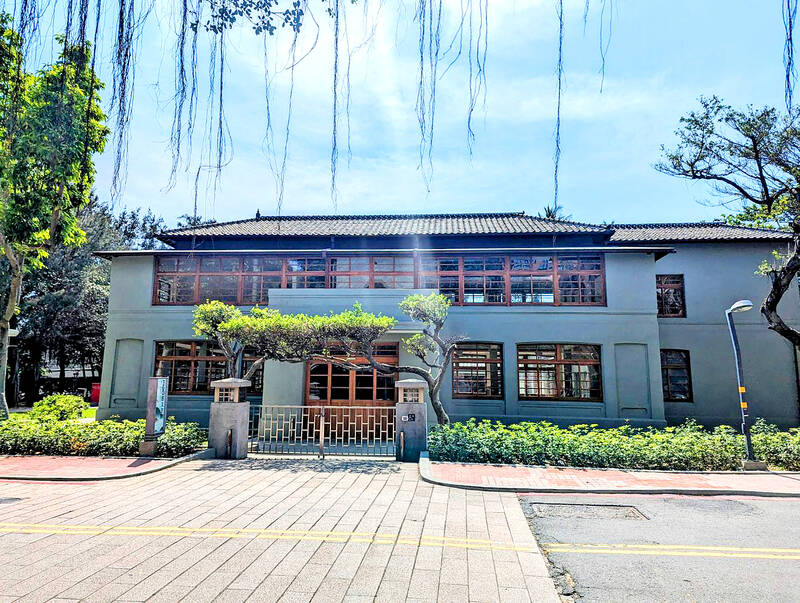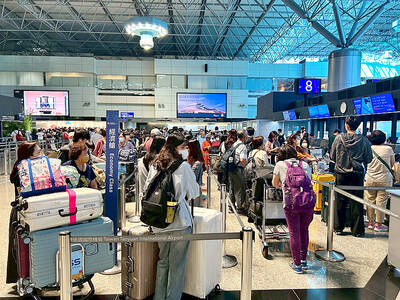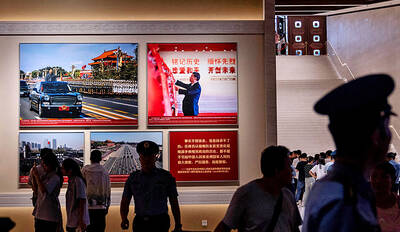The Kaohsiung Cultural Affairs Bureau has removed Chiang Kai-shek’s (蔣介石) name from a tourist attraction at its Sizihwan (西子灣) waterfront to better reflect the Japanese-era building’s original motif and historic value.
The hall is now to be referred to as City-certified Historic Site of Sizihwan Hall (市定古蹟西子灣行館) and Former Takao Tourism Hall (原高雄觀光館) as its official name, which was approved by the Kaohsiung City Government this week.
A group of experts and culture researchers on the Cultural Assets Committee voted to remove the reference to Chiang, which had been added to the building 20 years ago.

Photo: Huang Chia-lin, Taipei Times
Construction of the building was completed in 1935 during the Japanese era, and its original name was Takao Tourism Hall.
The building was constructed to mark the 40th anniversary of the establishment of Japanese rule in Taiwan, and was used to promote tourism in Kaohsiung, then called Takao, information released by the bureau showed.
The building was taken over by the Navy Command Headquarters at the end of World War II, which transferred jurisdiction over the hall to the Presidential Office in 1952, to be used by then-president Chiang as his private retreat in southern Taiwan.
In recent decades, management came under nearby National Sun Yat-sen University.
In 2004, it was classified a city historic site and renamed the Sizihwan Chiang Kai-shek Hall (西子灣蔣介石行館).
At the time, cultural bureau members viewed Chiang as being “an important political figure, and the hall as his southern retreat an important symbol of Chiang’s presence in the city, therefore they felt it should bear his name to highlight its historic significance and special geographic location,” university officials said.
“However, research into the building’s history and restoration work has uncovered its original motif and architectural design, which calls for a more appropriate name to reflect is real cultural legacy and historic value. Therefore, the committee conducted a re-evaluation and recommended the name change,” officials said.
A meeting of experts and researchers last month could not reach a consensus on changing the name, so it resorted to a vote, and the outcome favored the removal of references to Chiang, the bureau said.
Recent restoration work on the building includes the demolishing of a breakfast room above the hall entrance, the restoration of its exterior design and original colors, removal of the surrounding walls, and repairing the large wooden panel windows, returning the building to its original Japanese-era style, bureau information said.
Recent work also recovered and restored the original warm-bath pool on the first floor inside the hall, which has a unique Japanese-era water outlet valve in the center. The pool had been buried when it was converted into a bedroom for servants when used as a retreat by Chiang.

Three batches of banana sauce imported from the Philippines were intercepted at the border after they were found to contain the banned industrial dye Orange G, the Food and Drug Administration (FDA) said yesterday. From today through Sept. 2 next year, all seasoning sauces from the Philippines are to be subject to the FDA’s strictest border inspection, meaning 100 percent testing for illegal dyes before entry is allowed, it said in a statement. Orange G is an industrial coloring agent that is not permitted for food use in Taiwan or internationally, said Cheng Wei-chih (鄭維智), head of the FDA’s Northern Center for

The Chinese military has built landing bridge ships designed to expand its amphibious options for a potential assault on Taiwan, but their combat effectiveness is limited due to their high vulnerability, a defense expert said in an analysis published on Monday. Shen Ming-shih (沈明室), a research fellow at the Institute for National Defense and Security Research, said that the deployment of such vessels as part of the Chinese People’s Liberation Army (PLA) Navy’s East Sea Fleet signals a strong focus on Taiwan. However, the ships are highly vulnerable to precision strikes, which means they could be destroyed before they achieve their intended

About 4.2 million tourist arrivals were recorded in the first half of this year, a 10 percent increase from the same period last year, the Tourism Administration said yesterday. The growth continues to be consistent, with the fourth quarter of this year expected to be the peak in Taiwan, the agency said, adding that it plans to promote Taiwan overseas via partnerships and major events. From January to June, 9.14 million international departures were recorded from Taiwan, an 11 percent increase from the same period last year, with 3.3 million headed for Japan, 1.52 million for China and 832,962 to South Korea,

REWRITING HISTORY: China has been advocating a ‘correct’ interpretation of the victory over Japan that brings the CCP’s contributions to the forefront, an expert said An elderly Chinese war veteran’s shin still bears the mark of a bullet wound he sustained when fighting the Japanese as a teenager, a year before the end of World War II. Eighty years on, Li Jinshui’s scar remains as testimony to the bravery of Chinese troops in a conflict that killed millions of their people. However, the story behind China’s overthrow of the brutal Japanese occupation is deeply contested. Historians broadly agree that credit for victory lies primarily with the Chinese Nationalist Party (KMT)-led Republic of China (ROC) Army. Its leader, Chiang Kai-shek (蔣介石), fled to Taiwan in 1949 after losing a